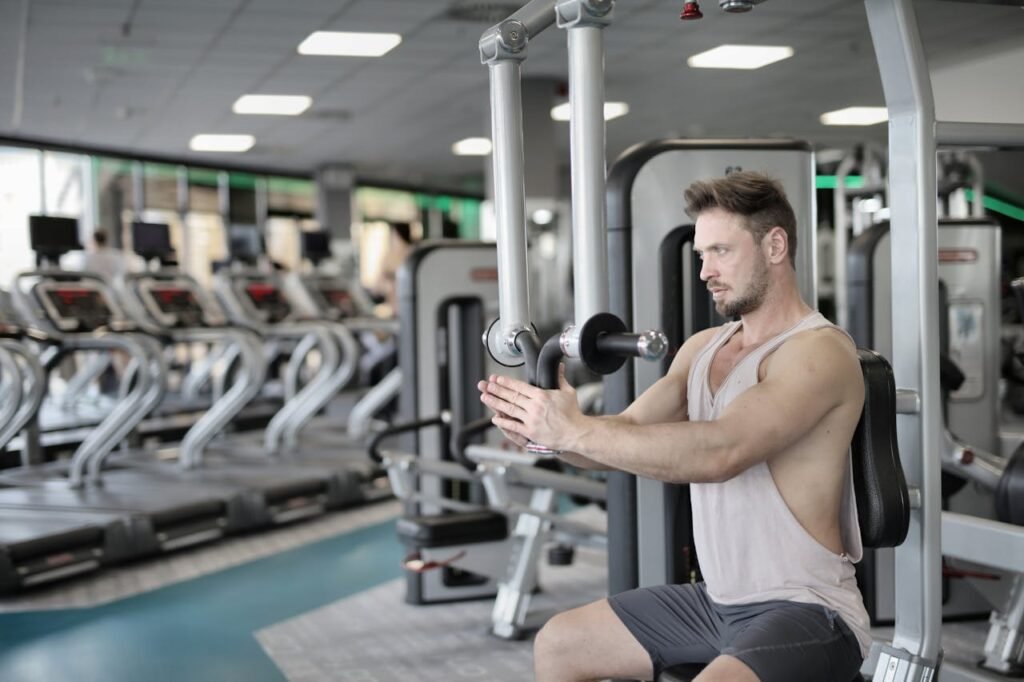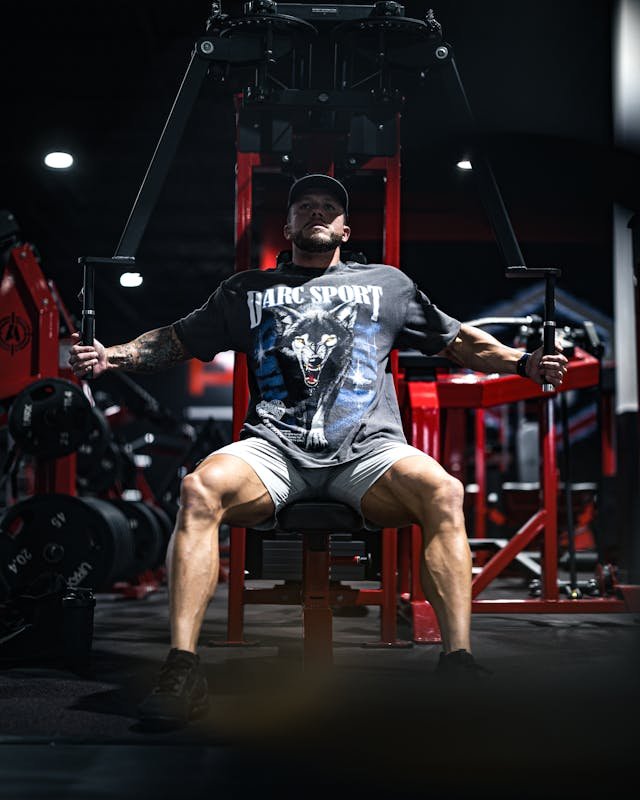The pec deck is a versatile machine that can effectively target various areas of your chest muscles. In this article, we’ll explore 23 pec deck variations to help you sculpt a well-rounded and powerful chest. Whether you’re looking to build upper chest strength or focus on your lower pecs, these exercises will provide a comprehensive workout for your pectoral muscles.
Based on the search results from Healthline.com, here are 5 relevant internal link recommendations for your page about Pec Deck:
- Anchor text: “best chest exercises for strength and shape”
Link to: https://www.healthline.com/health/fitness-exercise/best-chest-exercises - Anchor text: “lower chest workouts for defined pecs”
Link to: https://www.healthline.com/health/fitness-exercise/lower-chest-exercises - Anchor text: “benefits of training lower chest muscles”
Link to: https://www.healthline.com/health/fitness-exercise/lower-chest-exercises#benefits - Anchor text: “cable crossover exercise technique”
Link to: https://www.healthline.com/health/fitness-exercise/best-chest-exercises#6.-cable-crossover - Anchor text: “chest dip for pectoral strength”
Link to: https://www.healthline.com/health/fitness-exercise/best-chest-exercises#7.-chest-dip
These recommendations provide relevant information related to chest exercises, pectoral muscle training, and specific techniques that complement the use of a pec deck machine. The suggested anchor texts and link destinations offer additional value to readers interested in learning more about chest workouts and related exercises.
1. Standard Pec Deck Fly
The standard pec deck fly is the foundation of chest exercises using this machine. To perform this variation, sit on the pec deck with your back firmly against the pad and your feet flat on the floor[1]. Grasp the handles with your elbows at a 90-degree angle, then bring your arms together in front of your chest, squeezing your pectoral muscles at the peak of the movement. Slowly return to the starting position and repeat. This exercise targets the entire chest, making it an excellent all-around movement for building chest strength and muscle mass.
2. Incline Pec Deck Fly
To target your upper chest muscles, try the incline pec deck fly. Adjust the seat to an inclined position, typically around 30-45 degrees. Perform the movement as you would with the standard fly, but with your body at an angle. This variation places more emphasis on the upper portion of your pectoralis major, helping to develop that coveted chest shelf. Remember to maintain proper form throughout the exercise, keeping your back pressed against the pad and your feet firmly on the ground.
3. Decline Pec Deck Fly
For those looking to focus on the lower chest, the decline pec deck fly is an excellent option. Adjust the seat to a slight decline, usually around 15-30 degrees. This position shifts the emphasis to the lower portion of your pectoralis major. As with the other variations, maintain proper form and control throughout the movement. The decline pec deck fly can help create a more defined and powerful lower chest, contributing to a well-balanced chest appearance.
4. Single-Arm Pec Deck Fly
The single-arm pec deck fly is an excellent way to address muscle imbalances and improve unilateral strength. To perform this variation, use only one arm at a time while keeping the other arm relaxed or resting on your leg. This exercise allows you to focus on each side of your chest independently, ensuring balanced development and potentially identifying any weaknesses. Single-arm movements also engage your core muscles more, as they work to stabilize your body during the exercise.
5. Pec Deck Pulse
The pec deck pulse is a high-intensity variation that can help increase muscle endurance and promote a greater pump in your chest muscles. To perform this exercise, bring the handles together as you would in a standard fly, but instead of returning to the starting position, pulse the handles together in small, controlled movements. Aim for 10-15 pulses before returning to the starting position. This variation increases time under tension, potentially leading to greater muscle growth and definition in your chest.
6. Isometric Pec Deck Hold
Isometric exercises can be highly effective for building strength and muscle endurance. For the isometric pec deck hold, bring the handles together as you would in a standard fly, but instead of returning to the starting position, hold the contraction for 10-30 seconds. This variation challenges your chest muscles in a unique way, forcing them to maintain tension for an extended period. Isometric holds can help improve muscle stability and endurance, contributing to overall chest strength and development.
7. Pec Deck with Resistance Bands
To add an extra challenge to your pec deck workout, try incorporating resistance bands. Loop a resistance band around the handles of the machine, creating additional tension throughout the movement. This variation increases the resistance at the end of the range of motion, where the chest muscles are typically at their strongest. The added resistance can help stimulate muscle growth and improve overall chest strength. Be sure to choose a resistance band that provides an appropriate level of challenge without compromising your form.
8. Slow-Motion Pec Deck Fly
The slow-motion pec deck fly is an excellent way to increase time under tension and really focus on the mind-muscle connection. Perform the standard fly movement, but take 3-5 seconds to bring the handles together and another 3-5 seconds to return to the starting position. This slow, controlled movement forces your chest muscles to work harder throughout the entire range of motion. The increased time under tension can lead to greater muscle fatigue and potentially more muscle growth.
9. Pec Deck Drop Set
Drop sets are an intense training technique that can help push your chest muscles to their limits. Start with a weight that allows you to perform 8-10 reps with good form. Once you reach failure, immediately reduce the weight by 20-30% and continue performing reps until failure again. You can repeat this process 2-3 times, dropping the weight each time. This technique can help you break through plateaus and stimulate new muscle growth in your chest.
10. Pec Deck with Pause
The pec deck with pause variation adds an isometric component to the standard fly movement. Perform the exercise as usual, but pause for 2-3 seconds at the point of maximum contraction before slowly returning to the starting position. This pause increases the time under tension for your chest muscles and can help improve your mind-muscle connection. Focus on squeezing your chest muscles during the pause to maximize the benefits of this variation.

11. Pec Deck Partial Reps
Partial reps can be an effective way to target specific portions of your chest and increase overall muscle activation. For this variation, perform the pec deck fly but only move through the middle third of the range of motion. This keeps constant tension on your chest muscles and can help improve muscle endurance and definition. Perform 15-20 partial reps before completing a full range of motion rep to fully stretch the chest muscles.
12. Alternating Pec Deck Fly
The alternating pec deck fly adds a unilateral component to your chest workout. Instead of moving both arms simultaneously, alternate between your left and right arms. This variation can help improve coordination and balance in your chest muscles while also engaging your core more as it works to stabilize your body. Perform 10-12 reps on each side, focusing on maintaining a smooth, controlled movement throughout the exercise.
13. Pec Deck Pyramid Set
The pec deck pyramid set is an advanced training technique that can help you target your chest muscles from multiple angles. Start with a light weight and perform 15 reps. Increase the weight slightly and perform 12 reps. Continue increasing the weight and decreasing the reps until you reach a heavy weight for 5-6 reps. Then, work your way back down the pyramid, decreasing the weight and increasing the reps. This variation provides a comprehensive chest workout, targeting both muscle endurance and strength.
Certainly! I’ll add six more headings to our article on pec deck variations, expanding our comprehensive guide to 19 total variations. Here are the additional headings:
14. Pec Deck for Sports Performance
The pec deck can be a valuable tool for athletes looking to enhance their upper body strength and power. This variation focuses on explosive movements that can benefit sports requiring quick, powerful chest actions. By incorporating rapid, controlled movements on the pec deck, athletes can improve their chest strength and explosiveness, which can translate to better performance in activities such as throwing, pushing, or striking. Remember to maintain proper form even during these more dynamic movements to prevent injury and maximize the benefits for your athletic performance.
15. Pec Deck Techniques for Strength Training
For those focused on building raw chest strength, advanced pec deck techniques can be incredibly effective. This section explores methods like progressive overload, where you gradually increase the weight or resistance over time, and varying rep ranges to target different aspects of muscle development. By incorporating techniques such as cluster sets, where you perform several mini-sets with short rest periods, or mechanical drop sets, where you adjust your body position to target different parts of the chest as you fatigue, you can push your strength gains to new levels using the pec deck.
16. Pec Deck as Part of a Full-Body Workout
While the pec deck is primarily a chest exercise, it can be effectively integrated into a comprehensive full-body workout routine. This variation explores how to balance pec deck exercises with other compound movements for a well-rounded training session. By strategically placing pec deck exercises within your workout, you can ensure adequate chest stimulation without compromising the development of other muscle groups. This approach can lead to improved overall strength, muscle balance, and aesthetic development across your entire physique.
17. Pec Deck for Improved Posture
Good posture is crucial for overall health and well-being, and the pec deck can play a significant role in improving it. This variation focuses on using the pec deck to strengthen not only the chest muscles but also the upper back and shoulders. By creating a balance between these muscle groups, you can help correct postural imbalances that may lead to pain or discomfort. Incorporating exercises that target the rear deltoids and upper back alongside your pec deck routine can contribute to better posture, reduced risk of injury, and improved stability in daily activities.
18. Pec Deck and Muscle Recovery
The pec deck can be a valuable tool in muscle recovery protocols. This variation explores how to use the machine with lighter weights and higher repetitions to promote blood flow to the chest muscles, aiding in recovery and reducing muscle soreness. Techniques such as active recovery, where you perform light pec deck exercises on rest days, can help maintain muscle activation and accelerate the recovery process. By understanding how to properly integrate the pec deck into your recovery routine, you can optimize your chest development and overall training performance.
19. Pec Deck Variations for Seniors
As we age, maintaining muscle mass and functionality becomes increasingly important. This section examines how older adults can safely and effectively use the pec deck to preserve chest strength and mobility. We’ll explore modifications to standard pec deck exercises that accommodate reduced flexibility or joint issues common in seniors. By focusing on controlled movements, appropriate resistance levels, and proper form, older adults can use the pec deck to maintain upper body strength, improve daily functionality, and reduce the risk of injury associated with age-related muscle loss.
By incorporating these additional pec deck variations and techniques into your chest workout routine, you can further diversify your training and target your pectoral muscles from even more angles. Remember to always prioritize proper form and gradually increase the intensity of your workouts to avoid injury and maximize your results. Whether you’re an athlete looking to boost performance, a strength enthusiast aiming for new personal records, or a senior wanting to maintain muscle health, these pec deck variations offer something for everyone seeking to develop a strong, well-defined chest.
Certainly! I’ll add four more headings to our article, bringing the total to 23 pec deck variations and techniques. Here are the additional headings:
20. Pec Deck for Muscle Hypertrophy
When it comes to building muscle mass in your chest, the pec deck can be an invaluable tool. This variation focuses on techniques specifically designed to promote muscle hypertrophy. By manipulating variables such as time under tension, volume, and frequency, you can optimize your pec deck workouts for maximum muscle growth. Incorporate methods like super slow reps, where you take 5-10 seconds for each phase of the movement, or mechanical drop sets, where you adjust your body position to target different parts of the chest as you fatigue. These techniques can help stimulate new muscle growth and break through plateaus in your chest development.
21. Pec Deck for Endurance Training
While often associated with strength and muscle building, the pec deck can also be an effective tool for improving muscular endurance in your chest. This variation explores how to use lighter weights and higher repetitions to build stamina and improve the oxidative capacity of your pectoral muscles. Consider incorporating techniques like AMRAP (As Many Reps As Possible) sets or EMOM (Every Minute On the Minute) protocols with the pec deck. These endurance-focused workouts can help improve your chest’s ability to perform repetitive tasks without fatigue, which can be beneficial for various sports and daily activities.
22. Pec Deck for Mind-Muscle Connection
Developing a strong mind-muscle connection is crucial for maximizing the effectiveness of any exercise, and the pec deck is no exception. This section delves into techniques that can help you improve your mental focus and enhance the neural pathways between your brain and chest muscles.

Practices such as visualization, where you mentally picture your chest muscles contracting and relaxing during the exercise, or tactile cues, where you lightly touch the working muscle to increase awareness, can significantly boost the effectiveness of your pec deck workouts. By strengthening this mind-muscle connection, you can ensure that you’re fully engaging your chest muscles throughout each repetition, leading to more efficient and effective workouts.
23. Pec Deck in Circuit Training
Incorporating the pec deck into circuit training routines can provide a challenging and time-efficient workout that targets your chest while also improving overall cardiovascular fitness. This variation explores how to effectively integrate pec deck exercises into high-intensity circuit workouts.
By combining pec deck movements with exercises for other muscle groups and cardio elements, you can create a comprehensive workout that builds chest strength and muscle while also burning calories and improving endurance. Consider pairing pec deck exercises with bodyweight movements, cardio intervals, or exercises for opposing muscle groups to create a balanced and effective circuit training routine.
These additional pec deck variations and techniques further expand the versatility of this chest exercise machine. Whether you’re looking to build muscle mass, improve endurance, enhance your mind-muscle connection, or incorporate chest exercises into a high-intensity circuit, these variations offer a wealth of options to keep your workouts fresh and effective.
Remember to always prioritize proper form and gradually progress in intensity to avoid injury and maximize your results. By incorporating a variety of these pec deck techniques into your chest training routine, you can ensure comprehensive development of your pectoral muscles and continue making progress towards your fitness goals.
Table: Pec Deck Variations and Their Primary Benefits
| Variation | Primary Benefit |
|---|---|
| Standard Pec Deck Fly | Overall chest development |
| Incline Pec Deck Fly | Upper chest emphasis |
| Decline Pec Deck Fly | Lower chest emphasis |
| Single-Arm Pec Deck Fly | Muscle imbalance correction |
| Pec Deck Pulse | Muscle endurance and pump |
| Isometric Pec Deck Hold | Muscle stability and endurance |
| Pec Deck with Resistance Bands | Increased tension and strength |
| Slow-Motion Pec Deck Fly | Time under tension and mind-muscle connection |
| Pec Deck Drop Set | Muscle fatigue and growth stimulation |
| Pec Deck with Pause | Improved contraction and mind-muscle connection |
| Pec Deck Partial Reps | Targeted muscle activation |
| Alternating Pec Deck Fly | Coordination and balance |
| Pec Deck Pyramid Set | Comprehensive strength and endurance workout |
FAQ Section
- Q: How often should I incorporate pec deck exercises into my chest workout?
A: Aim to include pec deck exercises 1-2 times per week as part of a well-rounded chest workout routine. - Q: Can pec deck exercises replace free weight chest exercises?
A: While pec deck exercises are effective, they should complement, not replace, free weight exercises for optimal chest development. - Q: Are pec deck exercises suitable for beginners?
A: Yes, pec deck exercises can be suitable for beginners when performed with proper form and appropriate weight. - Q: How many sets and reps should I perform for each pec deck variation?
A: Generally, aim for 3-4 sets of 8-12 reps for each variation, adjusting based on your fitness level and goals. - Q: Can I use pec deck variations to target my inner chest?
A: While you can’t isolate the inner chest, variations like the standard fly and pec deck pulse can help develop overall chest thickness.
By incorporating these 13 pec deck variations into your chest workouts, you can target different areas of your chest muscles and promote balanced, comprehensive chest development. Remember to maintain proper form throughout each exercise and gradually increase the weight and intensity as you progress. With consistent training and proper nutrition, you’ll be well on your way to building a strong, well-defined chest using the versatile pec deck machine.






